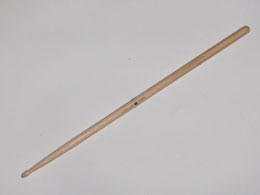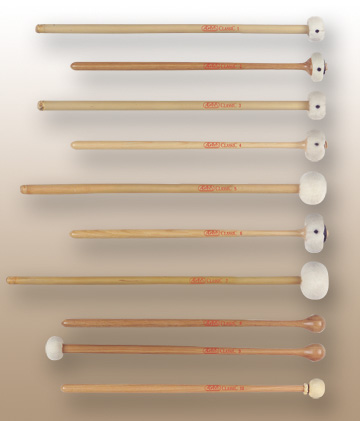
: : : Drumset : : Instruments : the sticks
The drum sticks

First accessory invented and used since immemorial time (first alone and then in pairs, one in each hand), there are several different kinds.
The snare sticks (or European military drum sticks) are by far the most widely used, due to their exceptional handling qualities (including the rebound and, therefore, double stroke rolls) expressiveness and perceptibility of their attack.
 A drum stick is usually made from a single piece of wood (with the grain), except the traditional prestige military drumsticks (photo: official drum sticks of "Musique (de l'armée) de l'air" ("air (force) music", French label Pro Orca), which welcomes foreign heads of state, in ebony and nickel), which have a cylindrical metal socket at the end ("butt") of the shaft (copper, brass, steel or nickel socket as in the Napoleonic era). Its diameter (thickness) ranges from 1.2 to 1.8 cm (0.5" to 0.7") and the average total length is about 40 cm (16'').
A drum stick is usually made from a single piece of wood (with the grain), except the traditional prestige military drumsticks (photo: official drum sticks of "Musique (de l'armée) de l'air" ("air (force) music", French label Pro Orca), which welcomes foreign heads of state, in ebony and nickel), which have a cylindrical metal socket at the end ("butt") of the shaft (copper, brass, steel or nickel socket as in the Napoleonic era). Its diameter (thickness) ranges from 1.2 to 1.8 cm (0.5" to 0.7") and the average total length is about 40 cm (16'').
The preferred material is "hickory" (American walnut) but there are also in ash wood, maple or oak, for their quality of elasticity and low density (which gives a perfect balance between taking of vibrations to preserve fingers joints, and strength).
The less a stick is dense, the more its fundamental tone is low (it sounds more "hollow"), and the more it will create a "ping" (tip stroke) well distinct on a cymbal. The "de luxe" marching band sticks are in ebony, stronger but more expensive (and heavier) because they are not played on metals, which inevitably spoil quickly a wooden stick (I strongly advise to not use them for playing on a modern drumset and in fact none does it now).
This is why brands have developed in recent years, sticks made of nylon or wooden sticks with nylon tip. These last have a much more high-pitched attacks (and therefore less audible on a cymbal), and poorer in terms of timbre. I do not recommend the use of 100% nylon sticks, which are absolutely unbreakable, yes, but "break" in opposite all the joints of the hand and fingers in the long run (think that it's permanent, so it is worth a little financial investment).
A snare stick is divided invariably in four distinct parts: the "shaft" (or "body"), perfectly cylindrical, the "tip" ("olive" in French, an overall spherical tip at one end), the "shoulder" (or "neck" in French), a thiner part between the tip and the shaft and finally the "butt" (generally rounded, allowing to hit strongly with it).
When the thiner part forms a curve associated with the tip, it is called "bead" ("goutte" in French, named after Robert Goute (model always marketed by Pro Orca again, Hickory), famous Drum Major of the the "French air force music" ( from 1953 to 1970) and author of compositions and methods for military drum in the 1940s), which is quite old and classic in French military drum (the "olive" seems to be an invention of Chinese origin but was at the beginning larger than the shaft with a wood ball) and was taken over by Buddy Rich ( drum sticks signature model "Buddy Rich" still marketed by Vic Firth American brand that produces quite dense sticks and painted in general).

But contemporary manufacturers now offer a huge variety of tip shapes: spherical, ovoid, conical, ogival, cylindrical, barrel-shaped, etc.

What you must remember to choose your shape of drum stick is that the more important will be the curve laterally the more its attack will be dry and contrasted (expressive) and it will be less controllable.
Some sticks are painted or lacquered (several coats of varnish). I do not recommend their use because the slightest drop of sweat it will slip through your fingers, and moreover, they tend to form dangerous fragments with the inevitable flaking of coating caused by multiple shocks (against the "rim" notably). In opposite, a low varnished stick (by spray), absorbs the excess of sweat while retaining just enough slip to allow the floating and avoid excessive friction, making "blisters" (you can also use adhesive tapes to avoid this, but normally a natural skin "corn" is formed at the point of friction after a few days of play, which allows to keep the sensations of touch) or even allergy to wood (however some manufacturers offer new models only sanded).
To obtain a single stroke roll allowing no distinction between right hand and left hand (illusion of high speed), it is imperative that the two sticks of a pair have not only the same shape, but also the same density. This is why many brands now offer pairs tuned by their care (linked by a cardboard sleeve). But nothing prevents to self-test their tone by hitting against a hard object in the same location (tile, table, etc.). A good indication of the wood density is the wood color (the darker it is the denser is the wood).
Many virtuosic drummers have achieved a level of notoriety and credibility that allowed them to market a drumstick model designed for them and by them. By listening to them playing, you may have a better idea of the type of drumstick you want to choose. But beware, the characteristics of the stick chosen must also depend on your hand (which may be with a different shape than your idol).
It is important to manage quickly to stay with one model of drumsticks, to not change your reflexes and sensations of space and weight.
Finally, note that a heavy stick (dense, hard) will damage your instruments and your joints and if the latter is more difficult to lift, it hits more easily (due to the weight) but more slowly (due to inertia). That is why more and more virtuosic drummers use the thinest drum sticks (it is the case of the "Elvin Jones" model (pictured on top) of the American brand Pro-Mark which I use invariably since 1998 and which is also very long, which makes it easier to move from one instrument of the set to another and does not require to lift elbows too much to play on the cymbals).

After the snare drum sticks (or drumset sticks), let's see other classical models, more rarely used in drumset, which are mainly used to create anecdotal effects.
First of all the drum mallets: used traditionally for toms, it is a kind of intermediary between the classical timpani mallets and bass drum bats. Like the later, they have a felt head to mute the attack, but have an average thickness that approaches a big snare drum stick.
 The bats ("batte" in French (same pronunciation), or bass drum mallets or sticks or "beaters") are much thicker (mostly used for gongs) and timpani mallets have a very thin shaft, sometimes in bamboo (following their Mongolian origin (photo)).
The bats ("batte" in French (same pronunciation), or bass drum mallets or sticks or "beaters") are much thicker (mostly used for gongs) and timpani mallets have a very thin shaft, sometimes in bamboo (following their Mongolian origin (photo)).
All these types of sticks are more or less soft and sometimes padded with wool or with fur, to soften even more.
The last category, vibraphone or marimba (large xylophone) sticks have a wooden ball just surrounded by a row of wool strands, or a rubber ball. Their attack is more powerful and dry than the maletts and the bats, they have often plastic elastic shaft.
All these kinds of sticks are highly appreciated by contemporaries jazz drummers like Jack DeJohnette or Max Roach , to create "hushed and melodic atmospheres" on the drums (which remains the sound of hand drums),  or "layers" effects on the cymbals, removing any perception of attack and rhythm (which remains the sound of the wind in the leaves, a torrent, of the rain, or the sea waves).
or "layers" effects on the cymbals, removing any perception of attack and rhythm (which remains the sound of the wind in the leaves, a torrent, of the rain, or the sea waves).
© 2005 Marc de Douvan Crédits Mentions légales
